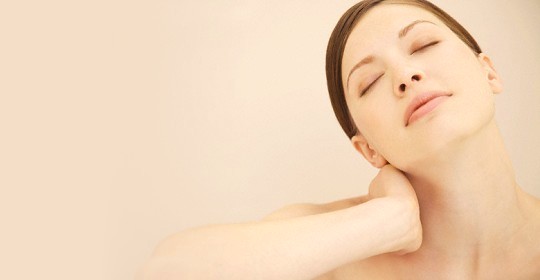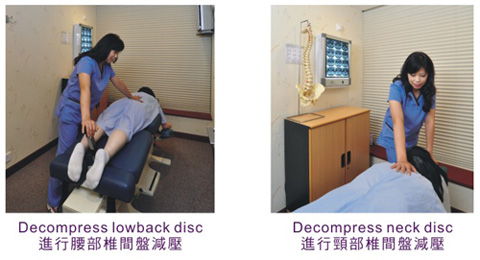
2014-02-02

Simple exercises and daily care for neck pain and stiffness
I believe that most people have experienced neck soreness and stiffness. Sometimes it only appears on the back of the neck. Sometimes the sides of the shoulders, upper back, forearms, and even fingers. In severe cases, headache, dizziness, and nausea may appear. When the patient moves or rotates the neck, especially when bending their lower back, the pain in the neck will increase.
The structure of the neck
The neck of has a concave curvature. It is made up of seven vertebrae, used to support a neck weighing about 12 pounds.
There is a layer of cartilage ( intervertebral disc ) between the vertebrae which can absorb shock. Each cervical spine is connected to each other by ligaments, and the outermost layer is covered with strong and elastic muscles, allowing the head and neck to move or turn in all directions.
The middle of the cervical spine is hollow and contains the spinal cord, which is the channel for transmitting messages and commands between the brain and the body. Each segment of the cervical spinal cord is divided into a pair of spinal nerves, which are used to control the sensory and motor functions of the upper limbs on both sides, the neck and the shoulders.
Causes of neck pain
[ 1 ] Degenerative arthritis
As we age, joints that are active and load-bearing tend to degenerate. Degeneration of the cervical spine is caused by the gradual dehydration and calcification of the intervertebral cartilage, which makes it fragile. The cartilage vertebral body will gradually grow bone spurs at the edges due to excessive pressure, thus pressing the surrounding sensitive tissues, such as ligaments and nerve root, causing pain and numbness.
[ 2 ] Disc protrusion
The outer layer of the disc is easy to wear and tear, causing the soft material in the middle to protrude, pressing the nerve root, and referral the pain to arms and fingers. The fifth and sixth segments and the sixth and seventh segments of the cervical spine have the highest chance of degeneration.
[ 3 ] Injury impact
When a person is at rest, a sudden impact from the rear causes the neck to jerk backward or the car brakes to cause the neck to lean forward. Both of these situations can cause serious injuries to the ligaments, muscles and even bones of the neck. Falling and incorrect exercise posture can also sprain the neck.
[ 4 ] Incorrect posture
Most of the neck pain is caused by long-term incorrect posture, fatigue of the neck muscles and strained ligaments. The most common bad postures include bending over, head leaning forward, and the head’s center of gravity falling in front of the body’s midline, which puts extra pressure on the cervical spine and adds a lot of pressure to the muscles. At work, the bad habit of leaning the neck forward may be formed due to the inappropriate height of the workbench, insufficient lighting or emotional tension. In addition, obesity will also make the abdominal muscles soft and weak, resulting in incorrect back and neck posture.
[ 5 ] Rheumatoid Arthritis
This disease affects all synovial joints, causing joint swelling and pain.
Cox® Decompression manipulation-No painkillers to relieve neck pain
Cox® Decompression manipulation-No painkillers to relieve neck pain
If you feel neck pain and finger numbness, you should get immediate medical attention. First, the chiropractor will conduct a detailed examination and, if necessary, take X-rays to find out the exact cause of the pain or numbness. Chiropractors will correct functionally displaced spine and joints with manual therapy to gradually reduce the pain in the affected area. Cox® Decompression Manipulation was invented by Dr. James M. Cox in the United States in 1960. He used two different techniques, “traction" and “decompression" to control the movement of the spine.
Cox® Decompression Manipulation effectively relieves symptoms such as neck pain, low back pain, shoulder pain, etc. It is particularly significant for pain caused by spinal problems such as intervertebral disc (cartilage) protrusion, sciatica, spinal stenosis, and spondylolisthesis.
Cox® Decompression Manipulation is a treatment method that has been proven through long-term clinical research and has been cited in many aspects. It does not rely on invasive treatment methods such as painkillers and surgery. Compared with other treatments, Cox® Decompression Manipulation is relatively mild, which can minimize pain as much as possible.

Daily care of the neck
[1] When washing your hair, it is best to rinse under the shower, and do not bend your head and wash in the sink. Keep your neck straight when washing your face, brushing your teeth, or shaving your beard.
[2] The height between the desk or workbench and the chair should be adjusted to the level so that the neck does not have to lean forward.
[3] When holding an object higher than your head, remember to move a stool and stand on it, no matter how heavy it is. Avoid stretching out your hand to grab it.
[4] The correct way to lift and lift objects is to squat down, bring the object close to the body and then slowly lift it up.
[5] Avoid long-distance driving, take short breaks in the middle, and move your muscles and bones when you get out of the car. The distance between the driver’s seat and the steering wheel should be moderate so that the head, neck and spine can rest comfortably on the back of the chair.
[6] There is no need to reduce any movement, just carefully analyze the entire movement process and correct those that put pressure on the neck. Appropriate exercise can improve the cardiopulmonary function, and strengthen the muscles of the whole body, maintain the best condition of the body.
During the course of treatment, electrotherapy, ice compress or hot compress will be added as alternative treatment. The effect is to relieve pain, relieve muscles, reduce inflammation in joints and promote blood circulation.
Finally, will guide the patient how to pay attention to the correct posture. On the one hand, it can enhance the movement range and muscle strength of the neck, and on the other hand and learning the concept of how to prevent neck pain.

 Book an Appointment
Book an Appointment


